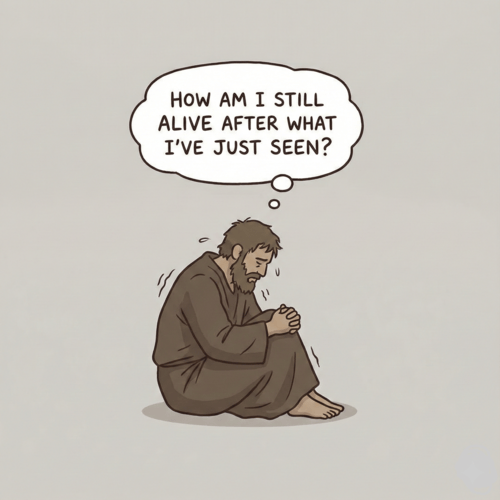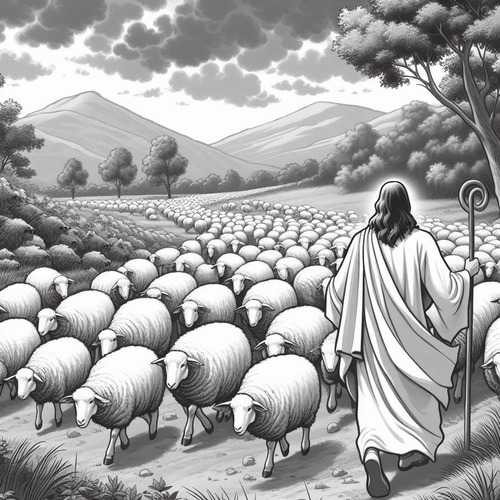Why Does God Say “The Life of the Flesh Is in the Blood”?
God’s declaration In Leviticus 17:11—”For the life of the flesh is in the blood”—leaves its echoes throughout Scripture. This isn’t merely a biological observation—it’s divine revelation connecting physical reality to spiritual truth. In establishing the principle, God lays the groundwork for us to understand both our physical existence and, more importantly, His redemptive plan through Christ. This simple statement about blood thus carries immense theological weight that ultimately points us to the cross.
THE BIOLOGICAL TRUTH
Blood is essential for life—it delivers oxygen and nutrients to every cell in our bodies, fights infection, and removes waste. Without blood, our physical bodies cannot survive. God’s declaration in Genesis 9:4 and Deuteronomy 12:23 emphasises this reality by connecting blood directly with life itself. The Creator, who designed our bodies, identifies this vital body fluid as containing “the life” of all flesh. The biological truth provides the foundation for understanding blood’s spiritual significance.
THE THEOLOGICAL SIGNIFICANCE IN THE OLD TESTAMENT
Under the Levitical system, blood took centre-stage in Israel’s worship. God established strict regulations around blood handling, including absolute prohibitions against consuming it (Leviticus 17:10-14). Why such emphasis? Because blood represented life itself—the most precious thing one could offer.
The sacrificial system required blood atonement for sin. When an Israelite brought an animal sacrifice, the shedding of blood symbolised the gravity of transgression against God. Sin disrupts life and demands death as its wage. Yet in His mercy, God provided a system where innocent blood could be shed as a substitute.
Blood also sealed covenants. When Moses sprinkled blood on people at Sinai (Exodus 24:8), it visibly confirmed the binding agreement between God and Israel. Blood wasn’t merely symbolic—it was the tangible means through which God provided temporary covering for sin and established relationship with His people.
CHRIST’S BLOOD AS THE ULTIMATE FULFILLMENT
The writer of Hebrews states plainly that “without the shedding of blood there is no forgiveness of sins” (Hebrews 9:22). The Old Testament sacrificial system was designed to point forward to Christ, whose blood would provide not just temporary covering but permanent cleansing.
While animal sacrifices needed constant repetition and could never fully remove sin, Christ’s sacrifice was once-for-all (Hebrews 10:1-14). His blood accomplished what animal blood could only symbolise. As the perfect Lamb of God, Jesus fulfilled and superseded the entire sacrificial system through His death on the cross.
THE REFORMED DISTINCTIVES ON BLOOD ATONEMENT
Reformed theology brings unique clarity to the doctrine of blood atonement through several key principles. These distinctives illuminate how Christ’s blood works with divine purpose and efficacy in God’s redemptive plan.
- Penal Substitutionary Atonement: Christ’s blood satisfies divine justice by taking the punishment we deserve. This goes beyond symbolic representation—Jesus literally becomes our substitute, bearing God’s wrath against sin as outlined in Isaiah 53:5 and 2 Corinthians 5:21.
- Particular Redemption: Christ’s blood was shed with specific intention for His elect rather than for everyone universally. His sacrifice actually secures salvation for those the Father has given Him (John 17:9), not merely making salvation possible for all contingent upon human response.
- Complete Efficacy: The blood of Christ accomplishes everything it intends without human addition or supplementation. Unlike the incomplete covering of animal sacrifices, Christ’s blood perfects believers forever as Hebrews 10:14 declares, requiring no additional works or merit.
- Blood as Covenantal Seal: Christ’s blood establishes and guarantees the New Covenant promised in Jeremiah 31. When Jesus declares “This cup is the new covenant in my blood” (Luke 22:20), He is affirming His blood both initiates and secures all the covenant promises for God’s people.
- Union with Christ through Blood: Believers aren’t merely forgiven but actually united with Christ through His blood. This blood-bought union means we participate in His death and resurrection, receiving not just pardon but new life as described in Romans 6:3-4.
CONCLUSION: THE LIFE IS IN THE BLOOD
God’s declaration “the life is in the blood” bridges physical reality and spiritual truth. What began as a biological fact became the foundation for understanding sacrifice, atonement, and ultimately, our salvation through Christ. The crimson thread running from Eden to Calvary reveals God’s consistent redemptive plan.
In Revelation 5:9, the heavenly hosts worship the Lamb because He has “ransomed people for God by [His] blood.” The life that was in Christ’s blood has become our life—eternal life secured through His perfect sacrifice. This truth stands at the heart of our faith: life poured out that we might live.
THE LIFE IS IN THE BLOOD—RELATED FAQs
How does the blood of Christ relate to the Lord’s Supper? The Lord’s Supper directly connects believers to Christ’s blood sacrifice through sacred remembrance. When Jesus said “this is my blood of the covenant” (Matthew 26:28), He was establishing a means for His church to continually proclaim and participate in His sacrifice. Reformed theology views communion not as a re-sacrifice but as a genuine means of grace where believers receive spiritual nourishment.
What’s the difference between blood atonement in Christianity and pagan blood rituals? Pagan blood rituals often attempt to manipulate deities or natural forces through human effort. Christian blood atonement, however, is God’s initiative—He provides the sacrifice rather than demanding it from humans. The cross represents divine self-giving love rather than appeasement, with God Himself in Christ becoming the sacrifice (1 John 4:10).
Why was Jesus’ blood specifically necessary rather than just His death? Scripture emphasises blood specifically because it represents life given voluntarily rather than merely taken. Jesus’ blood carries His perfect, sinless life that was purposefully offered as ransom. Hebrews 9:14 highlights that Christ offered Himself “through the eternal Spirit,” showing the intentional, active nature of His blood sacrifice.
How should Christians respond to Jehovah’s Witnesses’ blood transfusion prohibition? The biblical prohibition against blood consumption concerns respect for life and idolatrous practices, not medical procedures. Blood transfusions save lives rather than disrespect them, aligning with Christ’s healing ministry. The Reformed approach emphasizes that ceremonial laws pointed to Christ who fulfilled them, freeing believers from their literal observance.
What does blood symbolism in Scripture teach us about God’s character? Blood imagery reveals God’s justice that requires sin’s penalty while simultaneously demonstrating His mercy in providing a substitute. This dual revelation shows God is both holy and loving, unwilling to compromise either attribute. The blood teaches that God doesn’t simply overlook sin but addresses it while providing redemption at His own expense.
How does Christ’s blood relate to sanctification, not just justification? Christ’s blood not only declares us righteous (justification) but also progressively makes us holy (sanctification). Hebrews 13:12 states that Jesus’ blood “sanctifies” believers, empowering transformation from within. The blood that justifies also cleanses our conscience from dead works to serve the living God (Hebrews 9:14).
Do Reformed believers take the phrase “covered by the blood” literally or figuratively? Reformed theology understands blood covering as both figurative and substantively real. While not physically applied, Christ’s blood genuinely provides legal, covenantal, and spiritual covering with real effects in both heaven and earth. This covering isn’t merely metaphorical but represents actual divine protection, acceptance, and purification as detailed in 1 John 1:7.
THE LIFE IS IN THE BLOOD—OUR RELATED POSTS
Editor's Pick

The Throne-Room Vision: Who Did Isaiah See?
The scene is unforgettable: Isaiah stands in the temple, and suddenly the veil between heaven and earth tears open. He [...]

The Angel of the Lord: Can We Be Certain It Was Christ All Along?
Throughout the Old Testament, a mysterious figure appears: the Angel of the LORD. He speaks as God, bears God’s name, [...]
SUPPORT US:
Feel the Holy Spirit's gentle nudge to partner with us?
Donate Online:
Account Name: TRUTHS TO DIE FOR FOUNDATION
Account Number: 10243565459
Bank IFSC: IDFB0043391
Bank Name: IDFC FIRST BANK






